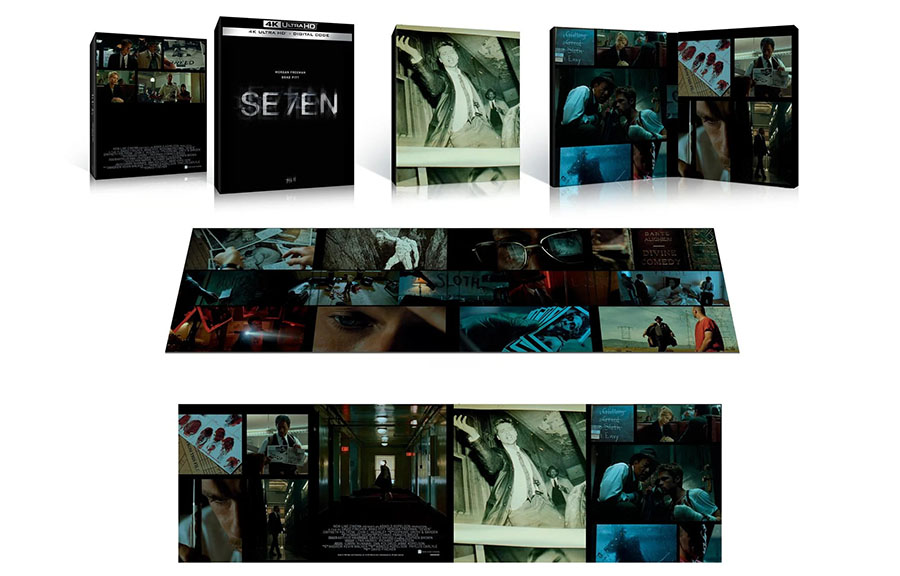Director David Fincher’s gruesome crime thriller from 1995 returns to home theaters now in an enhanced ultra-high definition disc format in Se7en (Warner Bros. Home Entertainment, rated R, 2.39:1 aspect ratio, 127 minutes, $24.99).
The smothering plot finds big-city homicide detective William Somerset (Morgan Freeman) nearing retirement and getting saddled with young and cocky rookie David Mills (Brad Pitt) while investigating a series of murders.
As the deaths begin to pile up, the clues lead to a pattern of torture based on the seven deadly sins with a sadistic serial killer (Kevin Spacey) on the loose.
The pair of cops must now outsmart a highly intelligent opponent who taunts them with each murder as he takes them down a horrifying rabbit hole that will test any normal person’s sanity.
Obviously, Mr. Fincher’s goal through documentary-style visuals, grisly body mutilations and enveloping sound was to make viewers as uncomfortable as possible. He succeeded in a riveting way.
The dynamic team-up of Mr. Freeman and Mr. Pitt also shines with each bringing an opposite emotional approach to their characters — methodical versus impulsive.
Mr. Spacey, as well as one would expect, unloads one of his best, twisted performances.
4K in action: Mr. Fincher approved the 4K remaster created from a whopping 8K scan of the original Super 35mm camera negatives.
Viewers are now bathed in the brilliance of cinematographer Darius Khondji’s noir-themed and sometimes rain-soaked presentation featuring sickly green, yellow and blue hues that dominate the often dreary urban landscapes.
One of the finest examples of the 4K experience presents a final outdoor scene — near a desert of transmission lines with the sun setting and the three main characters interacting — that delivers painstaking clarity and details to the shocking climax.
Also worth noting is the reported computer enhancements made using artificial intelligence to what is now a slightly new and arguably improved version of the film.
The result was not like a George Lucas’ Star Wars redo (i.e., adding characters) but subtle such as sharpening once out-of-focus moments.
As much as I can appreciate the overall results, I wonder what a black-and-white version of the film would look like with a less crisp and more grizzled presentation.
Best extras: Despite the digital goodies being culled from previous releases, specifically the 2000 Platinum series DVD, the ridiculous abundance allows viewers multiple choices to listen to key cast and crew deconstruct the movie.
Specifically, a whopping quartet of optional commentary tracks broken up under the headings of “Stars,” “Story,” “Picture” and “Sound.”
The first, and most entertaining, offers Mr. Fincher, Mr. Pitt, and Mr. Freeman focused on memories from the shoot and the fierce loyalty of the actors to keeping the story intact, allowing for the complexity of their characters to shine.
Next, a virtual roundtable with film studies professor Richard Dyer offers comments about story themes but also introduces a hodgepodge of scene-specific and non-scene-specific sound bites from editor Richard Francis-Bruce, screenwriter Andrew Kevin Walker, former New Line President of Production Michael de Luca and Mr. Fincher.
Another roundtable with Mr. Dyer in the same format introduces comments from Mr. Fincher, Mr. Francis-Bruce, Mr. Khondji and production designer Arthur Max.
Finally, and again, Mr. Dyer presents Mr. Fincher, sound designer Ren Klyce and composer Howard Shore as they explore the aural presentation and musical score.
Yeah, that’s a ton of information succinctly presented, with only the first track with the stars sounding like they are in the same room watching the movie (I think Mr. Freeman was still cut in) with the other tracks featuring zero interaction between the commentary participants.
Also worth noting are a selection of deleted scenes and alternate endings, all with optional analysis by Mr. Fincher as well as an outdated, but very detailed, overview (from 2000) of mastering the film for the home theater experience as broken down by audio, video and color correction.
I would certainly have enjoyed a new segment about Mr. Fincher incorporating AI in the restoration of the film to 4K.
As far as the packaging, a black case sporting only the film title contains a cardboard DigiPak with a magnetic clasp that opens and unfolds to reveal a four-panel spread showcasing color photos from the movie on the front and rear.
However, the 4K disc comes wedged between two of the cardboard pieces, making it a challenge to not only remove but delicately place it back into the very tight area. Owner beware.
• Joseph Szadkowski can be reached at jszadkowski@washingtontimes.com.




Please read our comment policy before commenting.